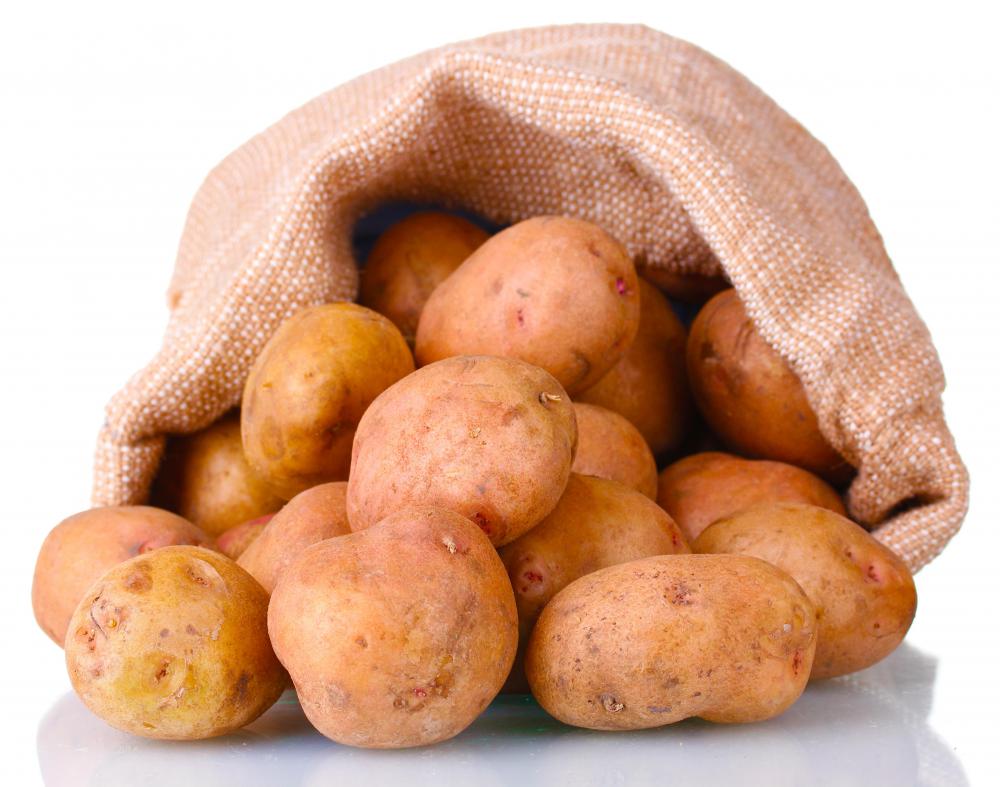At DelightedCooking, we're committed to delivering accurate, trustworthy information. Our expert-authored content is rigorously fact-checked and sourced from credible authorities. Discover how we uphold the highest standards in providing you with reliable knowledge.
What is an Irish Potato?
An Irish potato is an edible tuber from the Solanum tuberosum plant, which is actually native to South America, not Ireland. Irish potatoes are named after Ireland because they are closely associated with the Irish potato famine, a historical famine caused by a mold infestation of the Irish potato crop. You may also know an Irish potato as a “white potato;” Irish potatoes are probably one of the most commonly abundant forms of this popular tuber, and they are of the major sources of starch worldwide.
The flesh of an Irish potato is a creamy white, and it is covered with a white to cream-colored skin which may be mottled with black flecks or marks. Irish potatoes are classified as waxy, which means that they are ideally suited to boiling, as they will hold their shape well. They can also be roasted, broiled, or turned into potato salads and fried potatoes. They are less suitable for things like mashed potatoes, as they tend to turn gluey and dense when they are mashed.

Most markets stock Irish potatoes, along with an assortment of other potato varieties. Like other tubers, the Irish potato keeps well when it is stored in cool, dry conditions, and as a result it is usually available year-round. When you are selecting Irish potatoes to eat, look for specimens that do not have soft spots or slimy areas. Some discoloration is perfectly normal, as is a contorted shape. You may want to avoid especially knobbly potatoes simply because they are hard to peel.

You can also grow Irish potatoes at home, if you have a patch of well drained soil in a temperate spot in the garden. Potatoes prefer cooler weather, but they will grow in almost any conditions. To plant potatoes, amend the soil with compost and mulch in the early Spring, and plant out seed potatoes which you can obtain from a gardening supply store. Cover the soil with mulch to help retain moisture and insulate the potatoes, and keep the ground moist, but not wet.

As spring turns to summer, the potatoes will start to develop vines. As the vines grow, the tubers underneath will start storing energy for the parent plant; if left alone, the tubers will sprout into new potatoes in the next year, using their stored energy to feed the potato shoots. However, as a gardener, you will interrupt this process. Wait until the vines die back in the fall and then dig up the potatoes; try to get as many of them as possible, since a single missed potato can sprout into several volunteer plants in the following year. Brush the potatoes off for storage in a cool dry place, but do not wash them, as this can encourage mold.
AS FEATURED ON:
AS FEATURED ON:














Discussion Comments
This is a great article. It has opened my eyes and know the origin of the term Irish potatoes. Thanks to the author of this article.
I am astounded and very happy to have found this article. It completely exonerated our ancestors from the African continent who were exposed to Irish potatoes.
Until we came to the Uk potato was called Irish potato. Being well equipped with some of the English Colonies, every African comes to the Uk and when some went out to buy potatoes and asked for Irish potatoes as asking for a pound of Irish potatoes, you were told there is nothing called Irish potato. Just potato. Much to the embarrassment of those affected, word went round to not be embarrassed, but do not ask for Irish potato, but just potato.
Now I will get people to read the article.
Potatoes are not only staple food all around the world, but potatoes are also used in making vodka, in textile and paper industries.
Potatoes are the 4th most produced crop, after wheat, rice and corn.
A new crop is started by cutting potatoes in chunks. It has to be cut so that each chunk has an eye. It is from the eye that the new plant and potatoes will start growing.
So each year, a certain percentage of the crop has to be saved to be used for future planting.
Post your comments